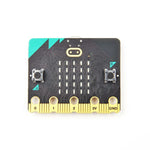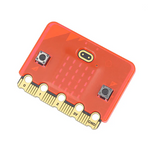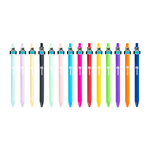As programming education becomes increasingly widespread, more parents and educators are focusing on how to choose the right entry-level coding tools for children. With its ease of use and strong expandability, the BBC micro:bit has become one of the top choices for coding beginners. However, with so many micro:bit starter kits on the market, selecting the one best suited for your child’s learning stage and interests can be challenging.
What Is the micro:bit?
The BBC micro:bit is a pocket-sized programmable development board equipped with a 5x5 LED matrix, accelerometer, compass, Bluetooth, and multiple input/output interfaces. It works with beginner-friendly platforms like Microsoft MakeCode, enabling kids to bring creative ideas to life through simple drag-and-drop coding. With its approachable design and powerful potential, micro:bit is widely used in STEM programs around the world for learners aged 8 to 16.
How to Choose the Right micro:bit Starter Kit?
A great starter kit can make all the difference in a child's coding journey, transforming abstract concepts into tangible creations. Here are the most important factors to consider for finding the best micro:bit kit for your child:
1. Does It Include the micro:bit Board?
This might seem obvious, but it's a common oversight for micro:bit for beginners. Many starter kits are designed as add-ons, assuming you already own a micro:bit board. First-time buyers often overlook this detail, only to find they need to make a separate purchase before they can start learning. Always look for kits clearly labeled with “micro:bit included” or those that offer it as an optional bundle. Ensuring the core board is part of the package guarantees an immediate, hassle-free start.
2. Component Variety – But More Importantly, Relevance and Quality
It’s tempting to assume that “more parts” equals a better kit—but the key is choosing the right components that align with your child’s specific interests and learning goals. The quality and durability of these components are also crucial for a smooth learning experience.
For Kids Who Loves Building Robots: If your child is excited about robots and movement, choose a kit rich in motors, wheels, servo controls, and distance sensors (like an ultrasonic module). This allows for projects like smart cars with obstacle avoidance, line-following capabilities, or even simple robotic arms. For example, kits like the
ELECFREAKS Cutebot Smart Car Kit are specifically designed with these components to bring robotic vehicle projects to life.

For Kids Who Loves Smart Gadgets: For kids who love to build interactive gadgets or smart home inventions, look for kits with a diverse array of environmental sensors (e.g., temperature, light, sound, humidity), display modules (like OLED screens), and input buttons/switches. These components enable projects such as mini weather stations, smart alarms, or automated light systems. For example, the ELECFREAKS Smart Home KIt provides a comprehensive set of such sensors and modules, perfect for building these interactive systems.
For Creative Kids Who Love Games and Art: If your child enjoys digital art, music, or creating games, a kit with extensive LED matrix capabilities, sound modules, arcade-style buttons, and perhaps even joysticks would be ideal for designing interactive games and light shows. For example, the
ELECFREAKS Retro Arcade Kit is specifically designed with these features, enabling children to unleash their creativity in interactive digital art and game design.
3. Learning Resources and Tutorial Support:
A kit’s long-term value often lies in the quality and breadth of its learning resources. This is where a good kit transforms into a great educational experience. Look for kits that come with:
-
Step-by-step Project Guides: Clear, visual instructions that walk your child through each project, ensuring success and building confidence.
-
Progressive Lesson Plans/Curricula: Resources that gradually introduce new concepts, building skills systematically from basic commands to more complex logic.
-
Online Support: Beyond physical manuals, access to online video tutorials, downloadable code, FAQs, and troubleshooting guides is crucial for overcoming challenges and encouraging independent learning.
4. Age Appropriateness and Skill Level Progression:
The best micro:bit kit balances fun with an appropriate level of challenge. The kit’s content and complexity should align with your child’s current age and cognitive development to foster interest, not frustration.
-
For Younger Learners (e.g., 8+): Kits should emphasize simple assembly with large, colorful parts and easy, plug-and-play connections. The focus should be on immediate, tangible results using block-based programming.
-
For Older or More Experienced Learners: For those ready for a deeper dive, modular kits that allow for advanced customizations (e.g., integrating IoT sensors, AI modules, or advanced robotics components) are ideal. The kit should offer new challenges as your child's confidence and skills develop, supporting their progression from visual coding to text-based programming.
5. Brand Reputation and Community Support
Choosing a brand with a strong reputation for quality and customer support ensures a smooth and worry-free learning journey. Look for brands that:
-
Provide active community forums or user groups where learners can share projects, ask questions, and collaborate.
-
Regularly update their tutorials, resources, and even firmware to keep content fresh and relevant.
-
Offer responsive customer service and technical support to assist with any product-related queries or troubleshooting.
How ELECFREAKS Kits Empower Young Learners
While many excellent brands contribute to the micro:bit ecosystem, such as Kitronik, DFRobot, and Seeed Studio (Grove), ELECFREAKS stands out as a particularly suitable choice for empowering young learners. Our commitment goes beyond just hardware; we focus on creating an engaging and supportive learning environment that truly fosters a child's growth in coding.
ELECFREAKS offers diverse kits tailored to all ages and skill levels, from beginner-friendly setups to advanced modules for IoT or AI exploration. All kits support Microsoft MakeCode for intuitive block coding, with seamless progression to Python and JavaScript. Each product includes professional after-sales support and access to a vibrant community, offering project showcases, teaching resources, and technical discussions. This comprehensive support, combined with our age-appropriate design and diverse components, makes ELECFREAKS an ideal partner for your child's coding adventure.
Conclusion
Choosing the right BBC micro:bit starter kit is a crucial step in sparking a child’s interest in coding and STEM. By selecting a kit that includes the micro:bit board, features high-quality and relevant components, offers strong learning resources, and matches the learner’s age and skill level, parents can ensure an engaging and rewarding educational experience.
Empower your child to begin their coding journey today with a well-chosen micro:bit kit—and unlock a world of endless possibilities in technology and innovation.













